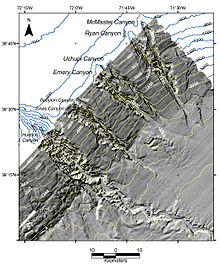
Back أخدود غائص Arabic Canyó submarí Catalan Podmořský kaňon Czech Unterseeischer Canyon German Cañón submarino Spanish Veealune kanjon Estonian Itsaspeko arroila Basque ژرفدره زیردریایی Persian Vedenalainen kanjoni Finnish Canyon sous-marin French






A submarine canyon is a steep-sided valley cut into the seabed of the continental slope, sometimes extending well onto the continental shelf, having nearly vertical walls, and occasionally having canyon wall heights of up to 5 km (3 mi), from canyon floor to canyon rim, as with the Great Bahama Canyon.[1] Just as above-sea-level canyons serve as channels for the flow of water across land, submarine canyons serve as channels for the flow of turbidity currents across the seafloor. Turbidity currents are flows of dense, sediment laden waters that are supplied by rivers, or generated on the seabed by storms, submarine landslides, earthquakes, and other soil disturbances. Turbidity currents travel down slope at great speed (as much as 70 km/h (43 mph)), eroding the continental slope and finally depositing sediment onto the abyssal plain, where the particles settle out.[2]
About 3% of submarine canyons include shelf valleys that have cut transversely across continental shelves, and which begin with their upstream ends in alignment with and sometimes within the mouths of large rivers, such as the Congo River and the Hudson Canyon. About 28.5% of submarine canyons cut back into the edge of the continental shelf, whereas the majority (about 68.5%) of submarine canyons have not managed at all to cut significantly across their continental shelves, having their upstream beginnings or "heads" on the continental slope, below the edge of continental shelves.[3]
The formation of submarine canyons is believed to occur as the result of at least two main process: 1) erosion by turbidity current erosion; and 2) slumping and mass wasting of the continental slope. While at first glance the erosion patterns of submarine canyons may appear to mimic those of river-canyons on land, several markedly different processes have been found to take place at the soil/water interface.[2][4]
Many canyons have been found at depths greater than 2 km (1 mi) below sea level. Some may extend seawards across continental shelves for hundreds of kilometres before reaching the abyssal plain. Ancient examples have been found in rocks dating back to the Neoproterozoic.[5] Turbidites are deposited at the downstream mouths or ends of canyons, building an abyssal fan.
- ^ Shepard, F.P., 1963. Submarine Geology. Harper & Row, New York
- ^ a b Continental Margin Sedimentation: From Sediment Transport to Sequence Stratigraphy (Special Publication 37 of the IAS) March 2009, by Charles Nittroeur, pg 372.
- ^ Harris, P.T., Whiteway, T., 2011. Global distribution of large submarine canyons: geomorphic differences between active and passive continental margins. Marine Geology 285, 69–86.
- ^ Submarine Canyon Archived 2016-03-07 at the Wayback Machine by Richard Strickland, 2004
- ^ Giddings, J.A.; Wallace M.W.; Haines P.W.; Mornane K. (2010). "Submarine origin for the Neoproterozoic Wonoka canyons, South Australia". Sedimentary Geology. 223 (1–2). Elsevier: 35–50. Bibcode:2010SedG..223...35G. doi:10.1016/j.sedgeo.2009.10.001.